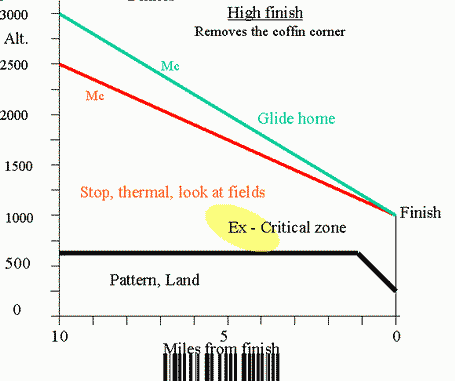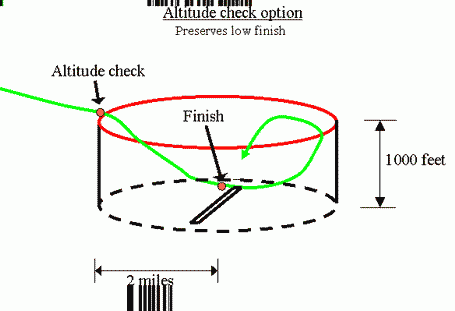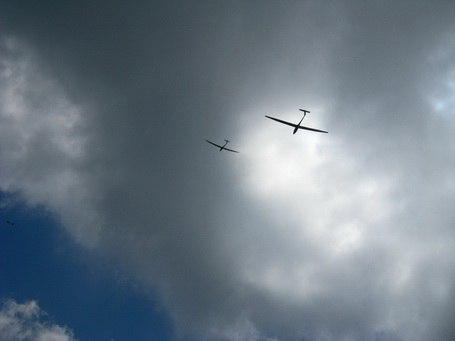
|
Strokovnega razmišljanja J. Cochrana, ki nam je dovolil že objavo članka Malo hitreje, prosim, ne bomo prevajali, saj je besedilo preprosto, predvsem pa je prav, da pred začetkom vsake sezone razmišljamo tudi o varnosti. Čeprav ima avtor v mislih predvsem tekmovanje, pa ne bo nič narobe, če sestavek preletijo prav vsi jadralci. Avtor je rekel bobu bob, denimo, o nevarnem področju, ki ga imenuje underappreciated “coffin corner” on final glides.
Safer Finishes As part of a broader study of US contest safety, I looked up all the crashes in the NTSB database that took place at contests. I was quite surprised at the number of these crashes at and near the home airport, involving the last portions of final glide, finish, and landing. We all know that midairs and off-field landings pose dangers, but we usually heave a sigh of relief when the home airport comes in to view. Table 1 summarizes these accidents. This is surely a statistical undercount, as many accidents are not reported to the NTSB. Still, it’s enough to help us think about the safety issues in this phase of flying.
Table 1. Accidents at and near the home airport. “Serious” or “Fatal” describes pilot injury; “Substantial” or “Destroyed” describes glider damage when there is no injury One pattern is clear: a good half of the accidents end in a stall/spin. But the root cause of stall/spin accidents isn’t “improper manipulation of the controls.” Stall spin accidents happen when the pilot’s attention is overloaded and distracted, and usually follow a 10 of 15 minute accident sequence in which one thing goes wrong after another. Many of the remaining accidents also tell this story. The home airport accidents trace back to a white-knuckle final glide, then quick decisions over how to handle the finish, pattern and landing, plus other distractions such as traffic in the air and on the ground or small mechanical problems. Off-field landing crashes typically start when the pilot deviates to an airport or a field as the lift dies, finds “unexpected” sink, has to pick a new field quickly at low altitude, has to adjust for trees or wires, etc. His attention is overloaded and distracted from flying mechanics. We have all encountered these high stress, attention overload situations. Usually, the pilots’ skill, training and quick thinking combine to save the day. Alas, these qualities are not perfect. We all pride ourselves in our ability to handle tough situations, but any pilot has some point at which his attention is overloaded, and some finite chance of making a mistake in high stress situations. It only takes a small chance of making a mistake to produce the accidents we see. To understand these accidents, we have to understand how pilots get to the high stress situation in the first place. There is an underappreciated “coffin corner” on final glides illustrated by Figure 1; a sequence of little decisions, each apparently sensible, that sets up a crash.
The figure graphs three glide slopes to the finish. The top slope is a MacCready 3 glide plus 300 feet. That glide is about 30:1, and has you flying 80 kts dry or 90 kts wet. It’s pretty conservative. The bottom slope is a MacCready 0 glide with no reserve. It’s 40:1; you’re flying 55 knots dry and hoping for the best. Notice how close euphoria is to desperation, and how they converge as you get close to the airport. Follow the solid line, and think “when would I stop and commit to landing out?” Start at 5 miles out, where I have labeled the “critical zone” for final glide decisions. The GPS reports a hundred feet or so over MacCready 0 – “you can get back.” All those stories will ring in your head: “well that was a squeaker, but, heh, heh, we popped over the fence and rolled in for the win.” You’ll lose 400 points if you stop and land; the whole contest is on the line. Even if you are one of the few pilots who will stop and land out with 100 feet still showing over a MacCready 0 glide, admit that you will be sorely tempted – and that less cautious pilots will zoom on by.
The critical zone is the last moment to do a proper off field landing or look for thermals with any chance of success. After this point, you’re committed to trying for the airport, and accepting a last-minute landing or a low-energy finish if it doesn’t work out. Why a “last minute” landing? In a proper off-field landing out on course, you divert towards fields, stop around 1,000’ to look down at the fields while looking for a thermal, and you can check for crops, slopes, ditches, wires, fences, obstructions, alternates, etc. None of this can happen past the critical zone. You’ll be making a beeline for the airport, saving every foot. All your field selection and evaluation will be done from less than 300 feet, after a straight glide. If you had 400 feet, you’d be blasting for the finish, not landing. Like anything else in aviation, a last-minute landing or a low energy finish are not a guarantee of a crash. If you are prepared – if you know the fields around the airport well enough to safely glide straight into them at 40:1, if your skill and experience level are high enough to fly accurately while thinking really fast, you can make a last-minute landing. A close look at the scoresheets reveals that our final glide experts do this once every few years, and they pull it off. It’s still a very high stress experience! With preparation and skill, showing up at the airport with low energy is also only a difficult moment. Several of the crashes seem to stem from indecision whether to attempt a flying finish or to roll the finish; preparing ahead of time for that decision would seem to help. The critical zone is only a few hundred feet high. Most of the time at 5 miles out, you have a comfortable, several hundred foot margin and you’re barreling along. Some of the time, heavy sink has put you well under MacCready zero. It’s clear you won’t make it, so you stop and do a proper landing. Only rarely will you enter the critical zone that leads to the hard decisions. That’s why many pilots have little personal experience with the situation. That, and the fact that most of the time pilots do handle the high stress decisions, keeps the crashes thankfully rare. Still, assembly failures and midairs are rare too, and we worry about them. The extraordinary accuracy of GPS may contribute to the problem. In the good old days, a pilot 50 feet over MacCready zero had a lot less confidence in the calculation and might have given up much sooner. Knowing that you have exactly 50 feet extra adds to the temptation to keep going. You can’t completely protect yourself by saying “I’ll just do cautious final glides.” My own 2 mile out landing (into a well-scouted field, I’m proud to report) resulted from a glide that started 1,500’ over MacCready 3, as illustrated by the dashed line. It can happen, and, eventually, it will. Once you arrive at the critical zone, by whatever means, you face a tough decision, and once past it you are committed. Better be prepared! The high finishThe temptation to keep going from the critical zone is entirely a creation of the rules. What’s ringing through the pilot’s head is the chance to stretch in to the airport and do a rolling finish for speed points. The following rules change could essentially eliminate these crashes: 1. A substantial minimum finish altitude. 500’ minimum, 800-1000’ would be better.
Look at Figure 2 and think about the decisions you would make with these rules instead of the usual rules. Above the MacCready 3 line, you push the nose down and blast home. Between MacCready 3 and MacCready 0, you “enjoy” most of the white knuckle stress of a marginal final glide. Will you make it? Will you blow it? The race is exactly the same as it is today. It’s just higher up, so if you don’t make it, you land at the airport with plenty of altitude to spare. Below the MacCready 0 line, it’s clear you won’t make it back for speed points, so you stop and deviate to good fields and thermals. The old critical zone is just like being at 1,000’ on course. There is no point in pressing on. You don’t fly straight in the ground for 5 more miles of distance points out on course, and it’s now no different here. The race finishes at 1000’. You and the 20 others that finished with you sequence in to a regular pattern and landing with time and altitude to spare. Objections You can see how the high finish eliminates the last minute landings and low energy finishes. Let me anticipate some of the objections. “But we’ll miss the fun and spectator appeal of low finishes.” Low finishes are fun. Sure, they’re a high skill maneuver – witness the two fatalities this year, and the rash of gear up landings and other mishaps, even by skilled pilots, at contests – but most pilots feel they’re not going to mess up; why ruin the fun?
A simple modification can preserve the traditional low pass. I call it the altitude check. Pass 1000’ 2 miles out, then finish as usual over the airport. If you don’t make the 1000’ hurdle, you only get distance points. Figure 3 illustrates the idea. Preserving the low pass is its disadvantage too – note how many crashes happen after the finish. The standard aircraft pattern is gone, with the time it gives for traffic sequencing, dealing with problems, doing checklists and so on. If on reflection pilots really think the low pass is important, I think this is a good compromise. You might miss the low finishes, and this option keeps them. Will you really miss low (over the ground) final glides? Will you really miss heart-stopping decisions whether to land in the last field or press on at 300 feet over the ground? Wouldn’t you really rather if everyone had to finish the race at 1000 feet, and nobody could beat you by daring to fly lower? If so, then this option is for you. “It’s unfair not to give speed points for rolling finishes” Imagine the poor pilot who does a rolling finish. He’s “made the task” Why can’t he get speed points? It seems a far too harsh penalty. It’s critical to the success of the idea that rolling finishes do not get speed points. Put yourself in the mind of a pilot at the critical point, 5 miles out and 800 feet. If pilots can get speed points for a rolling finish – if there is any substantial advantage to a rolling finish over landing here – they will push on. Why is it fair now that you can’t get speed points for landing two feet shy of the fence? We’ve all blown final glides. Isn’t it “unfair” to score a 80 mph flight that ends two feet shy of the fence less than a 40 mph flight that ends 2 feet over the fence? I think everyone understands why we do this. If you can get speed points for a fast landout, pilots will start their glides even lower, and we’ll have more landouts and low energy finishes. Good rules balance accuracy with incentives, and the rules are wisely set up here to provide good incentives. The high finish just moves what we have now up 1000 feet, away from the cold hard ground. Of course, tasks should be called 5 miles shorter; if you could “just do” a 250 mile task, you can “just do” a 245 mile task that ends at 1000 feet. With GPS, we can put the hurdle for speed points anywhere we want to. We can give speed points for any landout. We can let any landout within 5 miles of the airport count. We can put the line at the airport fence, as we do now. Or we can put the line higher up, as in the high finish. Decide what kind of race you’d like to fly, and what temptations you’d like to face and resist. The 2002 sports class rules include a 500 foot minimum finish altitude, but allow rolling finishes with a penalty. This is a good step in the right direction. The 500 foot minimum flying finish will focus the minds of pilots who arrive at 200 feet and 70 knots that they should commit to a rolling finish and not attempt (and stall out of) a flying finish. Still, it doesn’t address the pilot 5 miles out in the critical zone. He will still be irresistibly tempted to press on for the rolling finish speed points. Details: To keep pilots from blasting at redline and then zooming over the bar, you should have to be above 1000’ for, say, a half mile before the finish or altitude check. To minimize instrument problems, the rule should take the most favorable of pressure altitude at start and pressure altitude at finish as the ground altitude. As with the start gate height, the rule should probably just give a penalty for being slightly (100 feet) low. “Only a Bozo would do that. Can’t we rely on pilot judgment?” Clem Bowman’s accident changed a lot of minds. Until Clem’s accident, many pilots dismissed assembly failures as the sort of thing that only happens to lesser mortals. But Clem was a better, more experienced pilot than almost all of us. If he could do it, any of us could do it. We changed rules and procedures. Now we sign our wing tape. Blowing a last-minute landing or stalling and spinning in a fast, confused, low energy finish are much easier to do than an assembly failure. It’s not just bozos who crash. And not every pilot has the skill and experience of the winners. The contest has to be safe for the pilots in the middle and bottom of the scoresheet.
We can stress these issues in safety talks – and we will. But the safety talk, mentoring and education programs in American contest soaring are already excellent. They are a real credit to those that organize contest soaring, and have kept the accident rate as low as it is. They have been especially successful in reducing accidents that do not involve any competitive temptation, such as dehydration, assembly errors, and premature termination of tow crashes. Alas, since they are already so good, they are unlikely to reduce this kind of accident dramatically. If we do nothing new, the next 20 years are likely to produce another Table 1. Clem Bowman’s legacy should be more than signed wing tape: Like seatbelts and airbags in cars, safer rules and procedures can complement pilot education and judgment to really reduce the accident rate. In the last 20 years, the NTSB reports 9 contest fatalities, plus two more in rest and practice days, and 15 serious injuries. Per pilot, that’s not a lot more than in soaring overall, but I think we all would like it if the numbers were lower. If contests were statistically safer, they might attract more pilots. (Only about 1 in 30 SSA members has ever flown a contest.) And it sure would be a lot easier to get out the door if I could honestly tell my patient wife, “Honey, there hasn’t been a fatal crash at a US contest in the last 20 years.”
|
JS1-C Revelation, FES - kaj še ostane velikim Red Bull Flugtag – Malo drugačno tekmovanje Novost Urban Čeč Boštjan Pristavec Urban Čeč Janja Černič in Tanja Pristavec Luka Žnidaršič John Cochrane Urban Čeč Urban Čeč Jadralno letenje v hribih - tveganje? Varnost letenja: John H. Cochrane Pavel Magister |
|
||||||||||||||||||||||||||||||||||||||||||||||||||||||||||||||||||||||||||||||||||||||||||||








